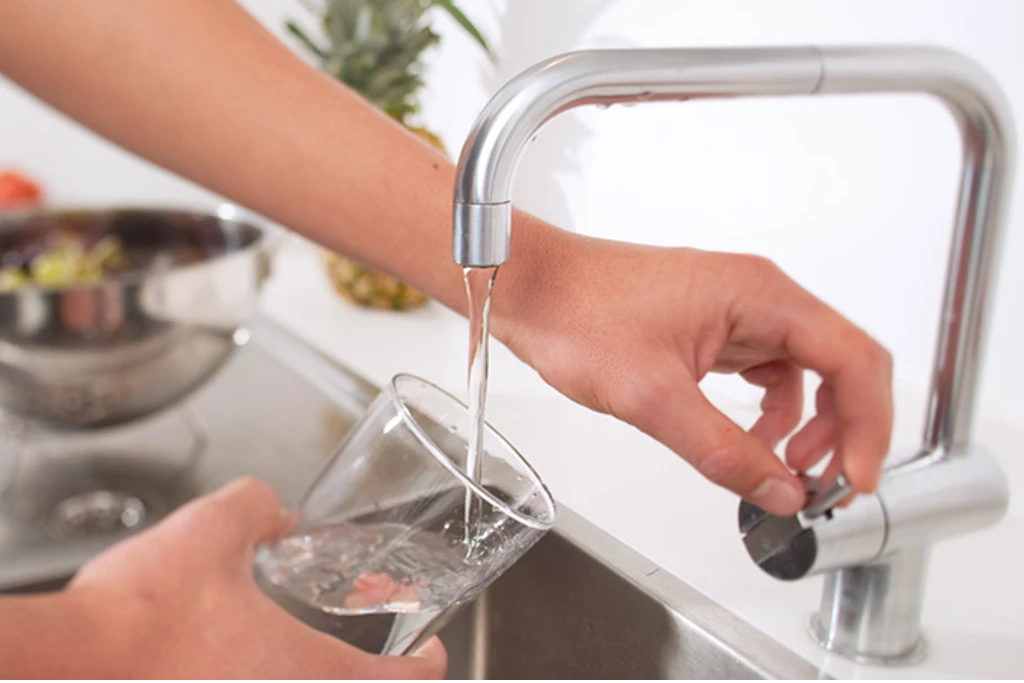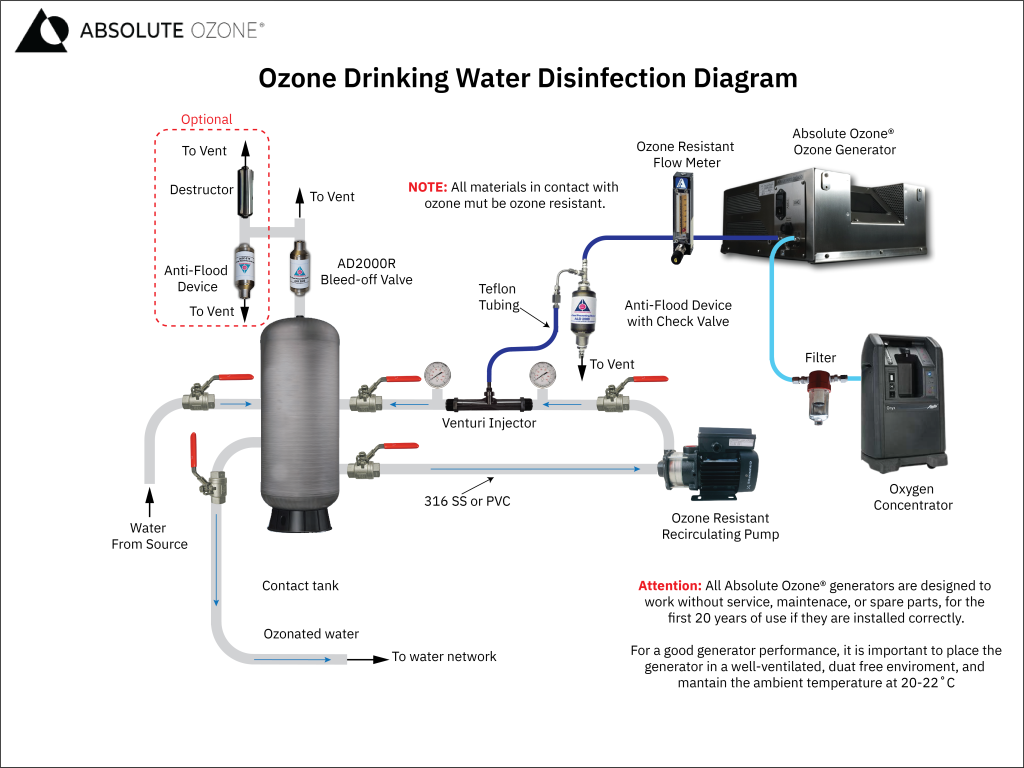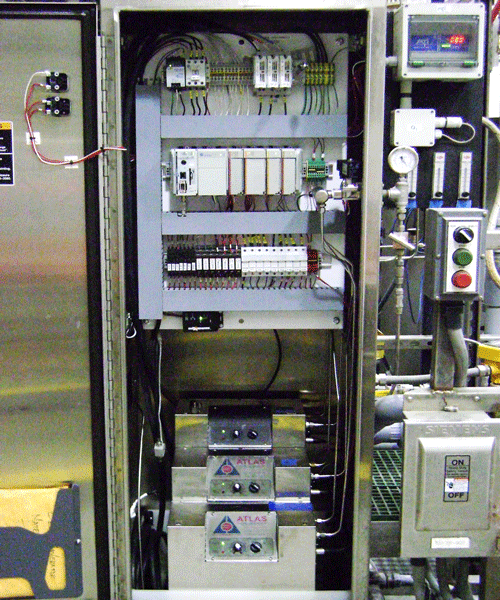
KEY FEATURES:
- It is the most economical method of water disinfection
- It is not associated with any harmful illnesses, unlike most chemical disinfectants
- Suitable for any drinking water disinfection system
- Is the most effective and fastest-reacting disinfectant
- Injection systems can be easily automated and do not require any supervision
- Implementation can be easily monitored, even remotely
- Implementation does not require any storage facility or specially trained personnel
- It does not create any residue that has to be rinsed or flited down from the water
- It is ecologically clean and does not harm the environment
OZONE DRINKING WATER DISINFECTION
Water contaminated by bacteria is a serious problem. It is the leading cause of gastroenteritis. Disinfectants have played a vital role in inactivating microbial pathogens to reduce waterborne diseases. However, It is unfortunate that almost all chemical disinfectants used in drinking water treatment plants, such as chlorine dioxide or hydrogen peroxide, can produce harmful by-products.
The traditional system often disinfected water with chlorine. However, the chlorinated compounds in the water are toxic and can alter the genetic information of the cells and the level of acid in the blood. In addition, several studies have linked Long-term exposure to high levels of chlorination by-products to an increased risk of cancer. Additionally, the Environmental Protection Agency (EPA) issued new disinfection process guidance for the control of harmful disinfection by-products (DBPs) like trihalomethane (THM). As a result, more and more people are looking for chemical-free alternatives to disinfectants like the ozonification of water.
How ozone water treatment works
Ozonation is the process of killing microbes and removing organic and inorganic contaminants by dissolving ozone, the ozone gas is produced in situ by an ozone generator that exposed oxygen molecules to an electrical discharge, which splits the oxygen molecules into individual oxygen atoms. These oxygen atoms then combine with other oxygen atoms to form ozone (O3). The ozone produced in the ozone generator is then dispersed into the air to eliminate odors, bacteria, and other contaminants.
Ozonation is the process of killing microbes and removing organic and inorganic contaminants by dissolving Ozone; the ozone gas is produced in situ by an ozone generator that exposes oxygen molecules to an electrical discharge, which splits the oxygen molecules into individual oxygen atoms. These oxygen atoms then combine with other oxygen atoms to form Ozone (O3). The Ozone is then dispersed into the air to eliminate odors, bacteria, and other contaminants.
In a chemical reaction, ozone oxidizes organic substances and kills hazardous germs and viruses. It works as a potent oxidizing agent. It is a widely utilized method for treating drinking water in both industrial and municipal settings. Upon contact with contaminants or germs, ozone molecules bind and oxidize, thereby killing them. Ozone can be used at different stages of the procedure, giving wastewater treatment plants a high degree of flexibility.
We have seen an increase in the use of the ozone oxidation process as the primary method of drinking water disinfection in both large and small communities. Moreover, several studies proved that Ozone is the most efficient disinfectant for inactivating resistant microorganisms, bacteria, viruses, and protozoa without generating dangerous by-products. Also, it improves the removal of natural organic material and is effective for the oxidation and removal of several pesticides.
- Generation of Ozone: Ozone is generated from pure oxygen using an ozone generator, which uses an electrical discharge to create ozone gas.
- Dissolving Ozone in water: The ozone gas is then dissolved using a venturi injector.
- Contact time: The ozonated water is then allowed to sit for a specific time (usually a few minutes) to enable the ozone to react with the contaminants.
The ozonization process kills many microorganisms, including bacteria, viruses, cysts, and other pathogens. It is also effective in removing unpleasant odors and tastes and reducing the levels of certain chemicals and dissolved substances in water.
Advantages of ozone water treatment
There are several advantages of ozone water treatment systems:
- Effective disinfection: Ozone is a highly reactive gas that can effectively kill bacteria, viruses, and other pathogens in water.
- Chemical-free: Unlike traditional chemical disinfectants like chlorine, ozone treatment leaves no residual or harmful by-products in the water.
- Improved water quality: Ozone is a powerful oxidant that can effectively remove organic contaminants and improve the water’s taste, odor, and color.
- Removal of chlorination by-products: Ozone water treatment can effectively remove chlorination by-products like trihalomethanes (THMs), making it a popular choice for drinking water treatment.
- Increased safety: Ozone does not produce toxic disinfection by-products like chlorinated compounds, making it a safer option for drinking water treatment.
- Enhanced taste and odor: Ozone water treatment can improve the taste and odor of drinking water, making it more palatable.
Surprisingly, Another reason is that ozone disinfection is no longer more expensive. It is considerably more economical than any chemical alternative due to the development of new generations of highly efficient ozone generators like Absolute Ozone®.
How much Ozone is needed to disinfect water?
The amount of Ozone needed to disinfect water depends on several factors, including the type and concentration of contaminants in the water, the temperature, the pH of the water, and the desired level of disinfection.
As a general guideline, the recommended Ozone concentration for drinking water disinfection is between 0.2 and 0.5 mg/L. For water with higher levels of contaminants, a higher concentration of Ozone may be necessary. The contact time required for disinfection also depends on the concentration of Ozone, with longer contact times typically required for lower ozone concentrations.
It’s important to note that while Ozone is an effective disinfectant, it is also a highly reactive substance that can quickly break down into oxygen. Monitoring the ozone concentration in water and the contact time is essential to ensure an adequate disinfection level.
Get started today by contacting us to discuss your project specifications and requirements. Our team of engineers will be happy to assist you in selecting the best industrial ozone generator for your needs and provide you with a customized ozone water treatment system that meets your needs.
Ozone Disinfection Costs
We will do all the calculations to offer you the best generator for your application. In addition, we will suggest the necessary accessories and components. One of our studies demonstrated that correctly installed and operated ozone generators could disinfect water for less than $0.03 per m3. Finally, If you have a water disinfection project and would like to know if ozone treatment will work well for you, Contact us now. Absolute Ozone® provides unlimited assistance to ensure your success.
Why absolute Ozone generators are the best choice for water treatment
We have a highly experienced and knowledgeable engineering team that can assist you in the following areas:
- Selecting the Right Size Absolute Ozone® Ozone Generator for Your Ozone drinking water Application
- Supply the oxygen concentrator or help choose the correct oxygen supply by ensuring you have the correct air preparation/feed gas.
- Supply all necessary accessories such as online monitoring and control equipment.
- Help with a complete initial design, installation guidance, and process details with maximum profitability.
- Provide full technical support from expert application engineers every step of the way, before installation and throughout the years.
Contact us now, our staff will help you explore all the possibilities that ozone can offer your project.



